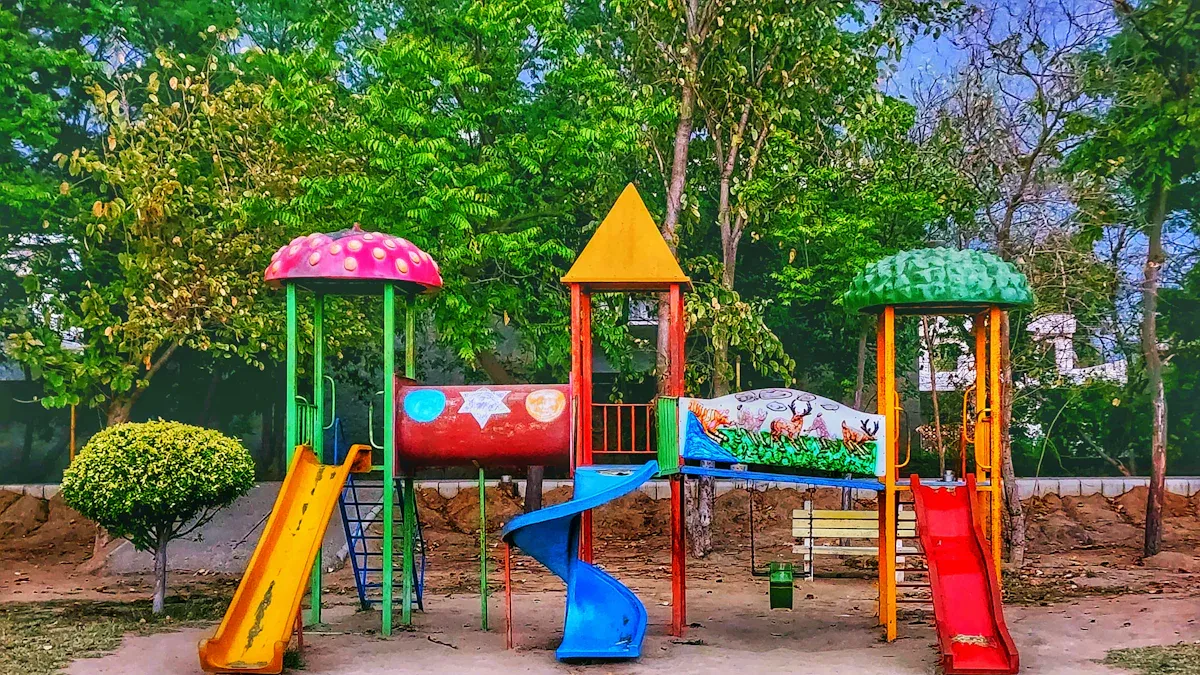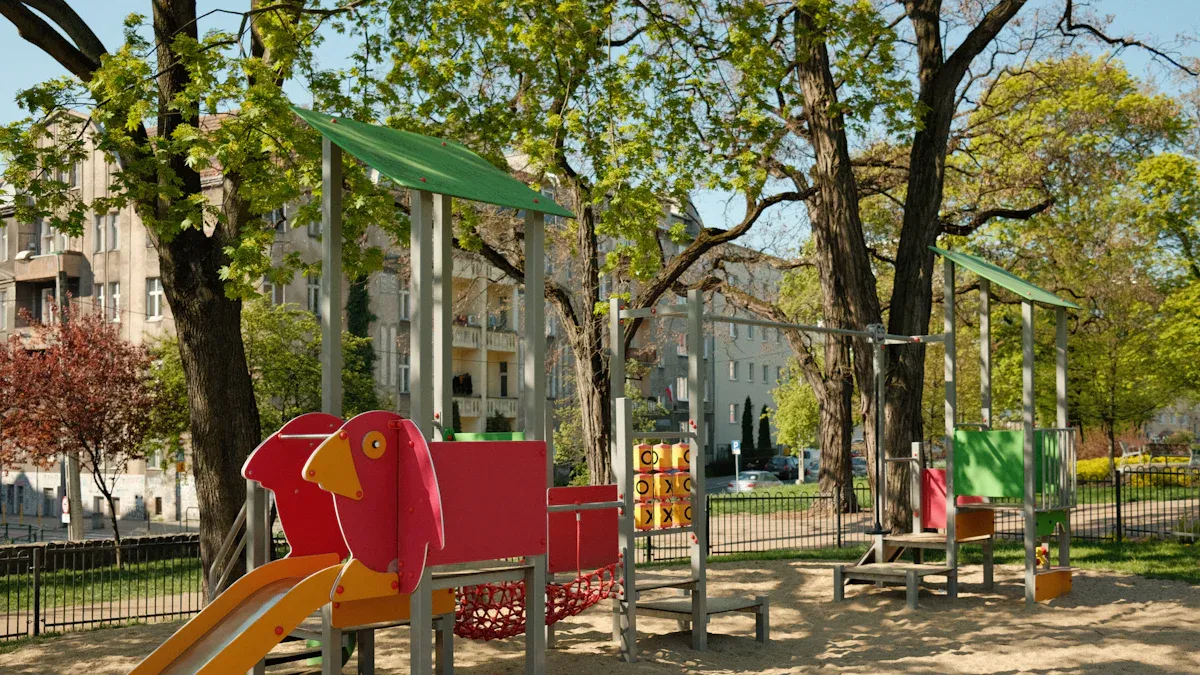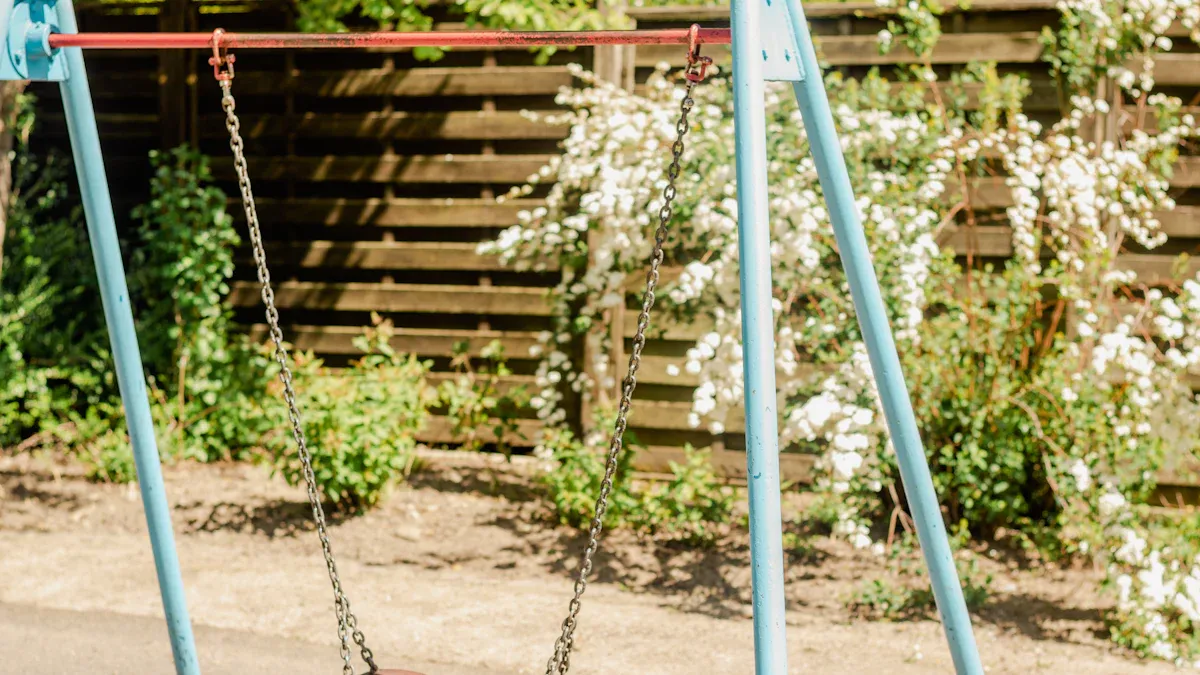
Urban daycares often face the challenge of limited outdoor space, making it difficult to provide engaging play areas for children. Compact swing sets offer a practical solution by transforming small spaces into vibrant, activity-filled zones. These sets promote physical development, improve balance, and enhance fine motor skills. Their thoughtful design ensures safety while maximizing the potential of a space-saving playground. The rhythmic motion of swinging also provides emotional benefits, creating a calming and joyful experience for children.
Key Takeaways
- Small swing sets turn tiny outdoor areas into fun play zones. They help kids grow physically and emotionally.
- Proper measurements and clear plans are key to making good, space-saving playgrounds for kids’ growth.
- Using equipment with many uses and inclusive designs lets all kids, no matter their age or ability, have fun playing.
Planning for a Space-Saving Playground
Measuring the available area
Accurate measurement of the available space is the foundation of designing a functional space-saving playground. Using reliable tools ensures precision and helps avoid costly errors. Tools like the Path Environment Audit Tool (PEAT) and the Community Park Audit Tool (CPAT) are particularly effective for assessing small outdoor areas. These tools provide evidence-based reliability and are easy to use for practitioners.
| Tool Name | Description | Evidence of Validity |
|---|---|---|
| PEAT | Path Environment Audit Tool for assessing trails | Reliability and validity evidence available |
| CPAT | Community Park Audit Tool, feasible for practitioners | Reliability and validity evidence available |
By employing these tools, daycare providers can identify the exact dimensions and features of their outdoor spaces. This step ensures that every inch of the playground is utilized efficiently.
Setting goals for the play area
Establishing clear and measurable goals is essential for creating a purposeful playground. Goals should align with the daycare’s vision and the developmental needs of children. For example, a goal like “children will improve their motor skills through structured play” is both specific and measurable.
| Goal | Clear Goal | Multiple Means |
|---|---|---|
| Students will be able to describe the relationships among different parts of an ecosystem. | Yes | Yes |
| Students will be able to describe the relationships among different parts of an ecosystem by making a multimedia presentation. | Yes | No |
By setting such goals, daycare providers can ensure that the playground fosters physical, social, and cognitive growth. These objectives also guide the selection of equipment and layout design.
Considering the needs of different age groups
A successful space-saving playground caters to children of varying ages and abilities. Younger children may benefit from low-height swings and sensory play elements, while older children might prefer climbing frames or combination units. Incorporating equipment that serves multiple age groups maximizes the utility of limited space. Additionally, inclusive designs ensure that children with disabilities can participate in play activities, fostering a sense of belonging and equality.
Choosing the Right Compact Swing Sets

Features of space-saving designs
Compact swing sets are designed to maximize functionality while minimizing the footprint they occupy. These designs often include vertical structures or stacked play elements, which allow multiple activities to occur in a smaller area. For example, swing sets with integrated climbing walls or monkey bars provide diverse play opportunities without requiring additional space. Modular designs also enable daycare providers to customize layouts based on the available area, ensuring every inch of the space-saving playground is utilized effectively.
Additionally, foldable or collapsible components can further enhance flexibility. These features allow daycare staff to reconfigure or store equipment when not in use, making the playground adaptable for various activities or events. By prioritizing space-saving designs, urban daycares can create engaging play areas even in the most confined spaces.
Multi-functional equipment for diverse activities
Multi-functional play equipment combines various activities into a single structure, promoting physical, social, and cognitive development. For instance, a swing set with attached slides or climbing frames encourages children to engage in different types of play. The table below highlights the benefits of incorporating multi-functional features into a space-saving playground:
| Play Feature | Benefits |
|---|---|
| Climbing Structures | Enhance gross motor skills and physical play opportunities. |
| Tricycle Paths | Improve coordination and balance through active play. |
| Natural Elements | Foster creativity and exploration by offering diverse play experiences. |
| Balancing Activities | Promote physical activity and improve stability. |
| Functional Play | Encourage running, jumping, and climbing, supporting overall physical development. |
By integrating such equipment, daycare providers can cater to a wide range of interests and abilities, ensuring every child has access to meaningful play experiences.
Materials and durability for urban environments
The materials used in compact swing sets play a crucial role in their longevity and performance, especially in urban settings. Plastic is a popular choice due to its durability, weather resistance, and lightweight nature. It is also cost-effective and available in vibrant colors, making it appealing for children. Metal, on the other hand, offers superior strength and can withstand heavy use, though it may require additional safety measures to prevent heat retention.
Wood provides a natural and aesthetically pleasing option, but it demands regular maintenance to remain functional. Composite materials combine the best features of plastic and metal, offering exceptional durability and resistance to extreme weather conditions or vandalism. These materials are particularly suited for urban environments, where playgrounds often face high traffic and exposure to the elements. Selecting the right materials ensures that the space-saving playground remains safe, functional, and visually appealing for years to come.
Prioritizing Safety in Small Play Areas
Impact-absorbing surfacing
The surface beneath playground equipment plays a critical role in reducing the risk of injuries. Research highlights the importance of impact-absorbing materials in minimizing the likelihood of serious head injuries.
A reduction in HIC from 1000 to 700 will lower the current 15% probability of a serious head injury to less than 5%. This reduction is considered statistically insignificant, indicating that the chance for a serious head injury is almost non-existent. Furthermore, lowering the HIC to 700 would significantly lower G-max, suggesting a potential reduction in long bone fractures.
Modern playgrounds often use rubberized mats, engineered wood fiber, or synthetic turf to cushion falls. These materials not only meet safety standards but also enhance the functionality of a space-saving playground by ensuring children can play safely in confined areas.
Ensuring proper clearance around equipment
Adequate clearance around playground structures is essential for preventing accidents. Safety guidelines recommend specific use zones for different types of equipment:
- A minimum of six feet of empty space should surround every structure.
- Swing sets require a use zone at least four times the height of their top rail. For an 8-foot swing set, this means 36 feet of free space on both sides.
- Slides taller than six feet need additional clearance, especially at the exit.
- Climbers should have a six-foot perimeter on all sides.
By adhering to these recommendations, daycare providers can create a safer environment while optimizing the available space.
Regular inspections and maintenance
Routine maintenance ensures that playgrounds remain safe and functional. Studies estimate that 33% of playground accidents could be avoided with a planned maintenance program. Key practices include:
- Conducting regular safety inspections to identify hazards.
- Cleaning equipment frequently to maintain hygiene.
- Lubricating moving parts for smooth operation.
- Checking ground surfacing for adequate cushioning.
- Repairing or replacing worn-out equipment promptly.
| Maintenance Practice | Description | Benefits |
|---|---|---|
| Routine Inspections | Regular checks for loose bolts, worn parts, and potential hazards. | Ensures safety and identifies issues early. |
| Timely Repairs | Fixing or replacing broken equipment immediately. | Prevents accidents and maintains playability. |
| Community Involvement | Engaging local community in maintenance efforts. | Promotes pride and shared responsibility. |
| Documentation | Keeping records of maintenance and repairs. | Verifies standard of care and aids in risk management. |
By implementing these measures, daycare providers can maintain a safe and enjoyable space-saving playground for children.
Enhancing the Space-Saving Playground
Adding seating for caregivers and children
Seating options in a playground serve both practical and social purposes. Comfortable seating for caregivers encourages them to stay longer, which increases playtime for children. Strategically placed benches or chairs also provide caregivers with clear views of the play area, ensuring they can supervise children effectively.
For children, quiet seating areas offer a space to rest and recharge. These spots are particularly beneficial in high-energy environments, allowing children to step away from the excitement when needed. Incorporating fold-away picnic tables or modular seating solutions can maximize the functionality of a space-saving playground.
| Evidence Description | Key Points |
|---|---|
| Comfortable seating for adults | Encourages longer stays, resulting in more playtime for children. |
| Quiet places for kids | Provides a retreat for children to relax and recharge. |
| Ample seating throughout | Ensures clear views of play areas and accommodates users with limitations. |
Incorporating shade for comfort and protection
Shade structures are essential for creating a safe and comfortable play environment. They protect children and caregivers from harmful UV rays, reducing the risk of skin damage and heat-related illnesses. Shaded areas also lower the temperature, making the playground more enjoyable during hot weather.
In addition to health benefits, shade structures extend the lifespan of playground equipment by shielding it from sun damage. Options such as fabric canopies, pergolas, or natural tree cover can be tailored to fit the design of the playground while enhancing its aesthetic appeal. By incorporating shade, daycare providers can ensure the space remains functional and inviting throughout the year.
Designing inclusive play areas for all abilities
Inclusive playgrounds foster a sense of belonging by accommodating children of all abilities. Features like ramps and wheelchair-accessible equipment enable children with mobility challenges to navigate and enjoy the playground independently. Sensory playground equipment, such as tactile panels and musical instruments, engages children with sensory processing disorders, promoting exploration and creativity.
Adaptive equipment, which can be customized to meet individual needs, ensures that every child can participate in play activities. Sensory swings, for example, provide therapeutic benefits by improving balance and coordination. By integrating these elements, daycare providers can create a truly inclusive space-saving playground that supports the physical, social, and emotional development of all children.
| Inclusive Design Strategy | Description |
|---|---|
| Playground Ramps | Allow children with mobility impairments to access play equipment. |
| Sensory Playground Equipment | Engages senses through tactile panels and interactive displays. |
| Sensory Swings | Promote balance and coordination for children with sensory challenges. |
| Wheelchair-Accessible Equipment | Ensures safe access for children using mobility devices. |
| Adaptive Playground Equipment | Customizable to meet diverse needs, ensuring inclusivity. |
Examples of Compact Swing Sets for Urban Daycares

Single-bay swing sets
Single-bay swing sets are ideal for urban daycares with limited outdoor space. These compact designs feature a single frame that supports one or two swings, making them perfect for narrow or irregularly shaped areas. Their simplicity allows for easy installation and maintenance, while their smaller footprint ensures they fit seamlessly into tight spaces.
These swing sets often include adjustable chains or seats, accommodating children of different ages and abilities. For younger children, bucket seats provide added safety and support. Older children can enjoy traditional flat seats, which encourage balance and coordination. Single-bay swing sets also pair well with other compact equipment, creating a cohesive and functional play area.
Combination units with swings and slides
Combination units integrate multiple play elements into a single structure, maximizing the use of limited space. These units often feature swings alongside slides, climbing walls, or tunnels, offering diverse activities that cater to various interests and developmental needs. By combining multiple features, these units encourage physical activity, social interaction, and imaginative play.
For example, a combination unit with a swing and slide allows children to transition seamlessly between activities, keeping them engaged for longer periods. These designs also reduce the need for additional equipment, saving both space and costs. Durable materials like powder-coated steel or high-density polyethylene ensure these units withstand heavy use in urban environments.
Modular designs for customization
Modular swing sets provide unmatched flexibility, allowing daycare providers to tailor playgrounds to their specific needs. These designs consist of interchangeable components that can be rearranged or expanded over time. This adaptability ensures the playground evolves alongside the daycare’s requirements.
Playgrounds in Borensberg, Sweden, and Arden Skole, Denmark, demonstrate the benefits of modular designs. Both feature distinct play units tailored for different age groups, promoting inclusivity and engagement. At Böda Sand, Sweden, the playground was customized to match brand colors and included elements for all abilities, showcasing the versatility of modular systems.
By choosing modular designs, urban daycares can create dynamic and inclusive play areas that maximize space and cater to children of all ages and abilities.
Maximizing small spaces in urban daycares transforms limited outdoor areas into dynamic playgrounds that foster physical activity and creativity. Compact swing sets enhance functionality while promoting vigorous play and emotional well-being.
| Design Feature | Impact on Activity Levels |
|---|---|
| Presence of green areas and playgrounds | Promotes children’s vigorous activity |
| Age-appropriate play equipment | Increases physical activity opportunities |
| Shading availability | Improves comfort and encourages longer playtime |
Daycare providers can explore innovative designs to create engaging environments that inspire exploration and growth.
FAQ
What is the ideal material for compact swing sets in urban environments?
Durable materials like powder-coated steel or high-density polyethylene work best. They resist weather damage and withstand heavy use, ensuring long-lasting performance.
How can daycare providers ensure safety in small playgrounds?
Providers should use impact-absorbing surfacing, maintain proper equipment clearance, and conduct regular inspections to identify and address potential hazards promptly.
Are compact swing sets suitable for all age groups?
Yes, many compact swing sets feature adjustable components and inclusive designs, making them adaptable for children of various ages and abilities.
Post time: Apr-07-2025
